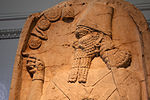Shalmaneser II (Salmānu-ašarēd II, inscribed mdSILIM-ma-nu-MAŠ/SAG, meaning "Being peaceful is foremost") was the king of Assyria in 1030–1019 BC, the...
6 KB (731 words) - 18:55, 20 September 2024
Shalmaneser (Salmānu-ašarēd) was the name of five kings of Assyria: Shalmaneser I (r. c. 1274–1245 BC) Shalmaneser II (r. 1030–1019 BC) Shalmaneser III...
704 bytes (124 words) - 06:38, 1 May 2023
Shalmaneser V (Neo-Assyrian cuneiform: Salmānu-ašarēd, meaning "Salmānu is foremost"; Biblical Hebrew: שַׁלְמַנְאֶסֶר Šalmanʾeser) was the king of the...
38 KB (5,051 words) - 18:28, 31 August 2024
Shalmaneser III (Šulmānu-ašarēdu, "the god Shulmanu is pre-eminent") was king of the Neo-Assyrian Empire from the death of his father Ashurnasirpal II...
15 KB (1,584 words) - 21:02, 21 November 2024
Shalmaneser IV (Neo-Assyrian cuneiform: Salmānu-ašarēd, meaning "Salmānu is foremost") was the king of the Neo-Assyrian Empire from 783 BC to his death...
10 KB (1,138 words) - 23:46, 26 September 2023
Assyrian kings Shalmaneser II (by Archibald Sayce) or IV (by François Lenormant). Eberhard Schrader argued that rather than Shalmaneser, Shalman was probably...
1 KB (147 words) - 06:55, 4 November 2024
Sargon is generally believed to have become king after overthrowing Shalmaneser V (r. 727–722), probably his brother. He is typically considered the...
88 KB (11,427 words) - 04:11, 10 November 2024
Shalmaneser I (𒁹𒀭𒁲𒈠𒉡𒊕 mdsál-ma-nu-SAG Salmanu-ašared; 1273–1244 BC or 1265–1235 BC) was a king of Assyria during the Middle Assyrian Empire. He...
4 KB (366 words) - 00:08, 21 November 2024
from 883 to 859 BCE. Ashurnasirpal II succeeded his father, Tukulti-Ninurta II. His son and successor was Shalmaneser III and his queen was Mullissu-mukannišat-Ninua...
24 KB (2,688 words) - 21:35, 2 November 2024
Nebuchadnezzar II (/ˌnɛbjʊkədˈnɛzər/ NEB-yuu-kəd-NEZ-ər; Babylonian cuneiform: Nabû-kudurri-uṣur, meaning "Nabu, watch over my heir"; Biblical Hebrew:...
90 KB (11,132 words) - 16:39, 20 November 2024
the Bohai Sea, the last group opposed to the Zhou dynasty. 1031 BC — Shalmaneser II becomes King of Assyria c. 1030 BC — The Belknap Volcano erupts in the...
1 KB (131 words) - 21:58, 25 March 2024
- Reign of Shalmaneser II ends, succeeded by his son Ashur-nirari IV. 1013 BC - Ashur-nirari IV is succeeded by his uncle, Ashur-rabi II, who ruled for...
2 KB (242 words) - 23:54, 12 February 2024
is also known as Hadad. Shamshi-Adad was a son and successor of King Shalmaneser III, the husband of Queen Shammuramat (by some identified with the mythical...
4 KB (366 words) - 19:49, 30 October 2024
Ashur-Dan II (Aššur-dān) (934–912 BC), son of Tiglath Pileser II, was the earliest king of the Neo-Assyrian Empire. He was best known for recapturing previously...
8 KB (950 words) - 17:53, 24 September 2023
symbols instead of cuneiform script. Aššur-uballiṭ II, also spelled Assur-uballit II and Ashuruballit II (Neo-Assyrian Akkadian: 𒀸𒋩𒌑𒋾𒆷, romanized: Aššur-uballiṭ...
18 KB (2,515 words) - 21:29, 7 November 2024
Ashurnasirpal II (r. 883–859 BC) the Neo-Assyrian Empire rose to become the dominant political power in the ancient Near East. Ashurnasirpal's son Shalmaneser III...
61 KB (7,507 words) - 13:23, 30 October 2024
Tukulti-Ninurta II (meaning: "my trust is in [the warrior god] Ninurta") was King of Assyria from 890 BCE to 884 BCE. He was the second king of the Neo...
4 KB (307 words) - 21:35, 2 November 2024
through the efforts of the kings Adad-nirari I (r. c. 1305–1274 BC), Shalmaneser I (r. c. 1273–1244 BC) and Tukulti-Ninurta I (r. c. 1243–1207 BC), under...
98 KB (12,848 words) - 09:46, 12 August 2024
List of Assyrian kings (redirect from Sharma-Adad II)
(8th century BC) stops at Tiglath-Pileser II (r. 967–935 BC) and the youngest, List C, stops at Shalmaneser V (r. 727–722 BC). One problem that arises...
87 KB (7,441 words) - 10:16, 4 November 2024
influential for the time period. He was the father of kings Ashur-nirari V, Shalmaneser IV, and Ashur-dan III. Tiglath-Pileser III described himself as a son...
5 KB (454 words) - 16:26, 28 July 2023
ADAD-NIRARI II (r. 911-891 BC) TUKULTI-NINURTA II (r. 890-884 BC) ASHURNASIRPAL II (r. 883-859 BC), m. Mullissu-mukannishat-Ninua SHALMANESER III (r. 859-824...
103 KB (12,892 words) - 10:00, 9 November 2024
Scorpion II (Ancient Egyptian: possibly Selk or Weha), also known as King Scorpion, was a ruler during the Protodynastic Period of Upper Egypt (c. 3200–3000 BCE)...
27 KB (3,310 words) - 15:32, 13 August 2024
Marduk-apla-iddina II (Akkadian: DMES.A.SUM-na; in the Bible Merodach-Baladan or Berodach-Baladan, lit. Marduk has given me an heir) was a Chaldean leader...
5 KB (508 words) - 05:52, 10 June 2024
The Black Obelisk of Shalmaneser III is a black limestone Neo-Assyrian sculpture with many scenes in bas-relief and inscriptions. It comes from Nimrud...
13 KB (1,272 words) - 21:35, 30 October 2024
later in his reign. Tukulti-Ninurta II and Ashurnasirpal II also forced Babylonia into vassalage, and Shalmaneser III (859–824 BC) sacked Babylon itself...
93 KB (12,339 words) - 01:36, 6 November 2024
following the death of the Kassite king Burnaburiash II, Ashur-uballit established Kurigalzu II on the Babylonian throne, in the first of what would become...
5 KB (540 words) - 16:51, 10 September 2024
Adad-nīrārī II (also spelled Adad-nērārī, which means "Adad (the storm god) is my help") reigned from 911 BCE to 891 BCE. He was the first King of Assyria...
5 KB (451 words) - 21:35, 2 November 2024
succeeded by his son, Shalmaneser II, who mentions him in one of his own inscriptions and later by another son, the long-reigning Aššur-rabi II. White Obelisk...
5 KB (519 words) - 02:07, 19 November 2024
Tiglath-Pileser II (from the Hebraic form of Akkadian Tukultī-apil-Ešarra) was King of Assyria from 967 BCE, when he succeeded his father Ashur-resh-ishi II, until...
3 KB (333 words) - 02:00, 10 May 2024
Mitanni (section Artatama I and Shuttarna II)
According to the royal annals (A.0.77.1) of Assyrian king Shalmaneser I (1270s–1240s) King Shattuara II of Hanigalbat, rebelled against Assyrian control with...
87 KB (11,083 words) - 06:09, 11 November 2024




















